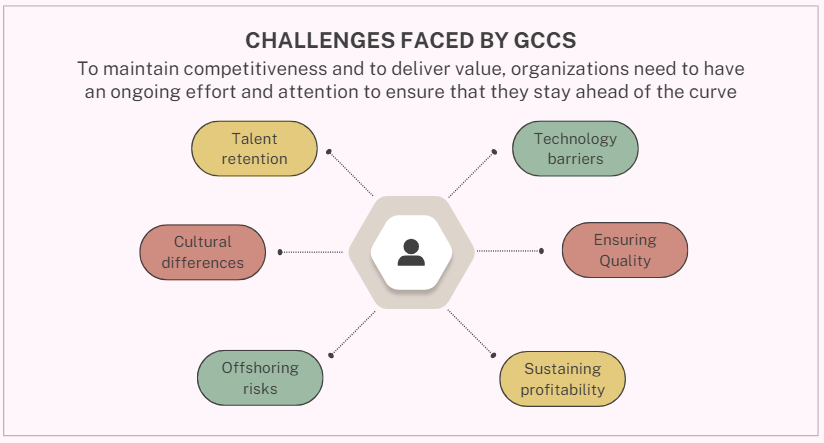
Originally Posted: Nasscom
Did you know there are roughly more than 1,500 Global Capability Centres or GCCs in India which account for more than 45% of the world’s entire GCCs, and roughly 70% of all US-based GCCs?
Given the pace at which GCCs are increasingly being established in India, it is evident that organizations have moved from viewing them as cost-effective institutions to being strategic and innovative tech centres of excellence.
Now, India, with a market size of over USD 35.9 billion (FY 2021), is growing at a CAGR of 10.8% and it is estimated that the total count of GCCs in India will increase to at least 2000 by 2026.
Its impact is not just going to be economic but also in innovation, creating an ecosystem of human capital, and social.
GCC Ecosystem Latest Trends, Challenges and Needs
Predominantly, the Global Capability Centres that we see now is a form of evolution from limited BPOs (Business Process Management centres) and with the growing need for IT and data capabilities that started as BPOs, expanded to building process excellence and building capabilities.
This change has brought in a new perspective for organizations and given GCCs the opportunity to move beyond the traditional parent organizational views and bring an integrated approach to operations. It has further evolved into an innovation centre within an organization by leveraging advancements in the space of AI-ML, big data, data analytics, data science etc. The GCC ecosystem is predominantly seen consuming AI, analytics, data engineering and visualizations segments – which are all proving to be game changers for the industry. This is enabling faster innovation, transformation, capability expansion, cost arbitrage and achieving strategic objectives.
GCCs today not only drive new processes or improve productivity but also create new capabilities and lead cross-functional innovations. As per the 'COE Hotspots of the World report by Zinnov India, 2022, Al/ML, IoT, data analytics and cloud computing are key digital focus areas for GCCs in India.
There are a host of ways in which GCCs can play with intelligent data, AI-ML, video and image analytics as well as the utilization of chat-based robots that use textual data as a source of conversation.
For example, a retail GCC uses its product data (image, product, brand, category, etc.) to group its products. Once grouped correctly, it helps the pricing teams to accurately price items within the same grouping. The information is visualized on a portal to enable accurate and real-time decisions. Earlier, the same process was cumbersome, manual and error-prone.
There are numerous other ways in which GCCs are using data to solve critical issues in health compliances, improving factory manufacturing processes, safety and maintenance of machinery, risk and fraud, FP&A, HR, supply chain, sales and operations, IT functions, logistics, etc.
This results in a new rendition of GCCs as being strategic and transformative to the parent organization by ensuring effectiveness, rapid experimentation, business continuum and actionable insights.
But despite the growth of the ecosystem, there are still some prominent challenges faced by GCCs. Here are some;

However, setting up an analytics capability hub and embedding analytics into an organization might be key to devising a winning strategy and creating a sound insights ecosystem.
Laying Down a Strategy for GCCs
The strategy which can be laid down involves incorporating an analytics journey for GCCs.
Firstly, this involves technology implementation – exploring innovative business applications and platform options.
Secondly, in order to achieve best-in-class analytics COE, it is important to work on establishing a solid organizational foundation. This should include COE adoption through effective change management and addressing newer evolving analytics areas like analytical storytelling, behavioural analytics, NLP, etc.
Third, via a service delivery model, it is possible to drive continuous improvement programs as well as self-service enablement.
Once this is done the analytics COE will touch the enterprise from the core to the edges in turn driving better collaboration and innovation, reducing costs and demonstrating ROI, among other benefits.
Measuring the Success of an Analytics Capability Hub
Benchmarking has become essential to manage the performance of global capacity centres especially if an organization wants to improve performance, understand industry trends and launch strategic imperatives going forward.
An end-to-end methodology should be holistic and include everything from speed-to-market, innovative thinking, customer centricity, analytics culture, business insights, service delivery, accessibility, financial performance, employee engagement, etc.
For example, in order to measure the success of one parameter such as speed-to-market, one must consider a few factors;
Comparing metrics and measuring success provides key GCC insights on areas of strength and opportunities for improvement. With the GCC ecosystem growing every year, it is important to go digital and leverage modern technology to achieve higher efficiency, lower costs, improved employee retention, and enhanced business agility. The GCC ecosystem in India is ripe for maturity, are you ready to take it to the next level?
Author: Gaurav Singh, Senior Vice President, Polestar Solutions
Comparing metrics and measuring success provides key GCC insights on areas of strength and opportunities for improvement.